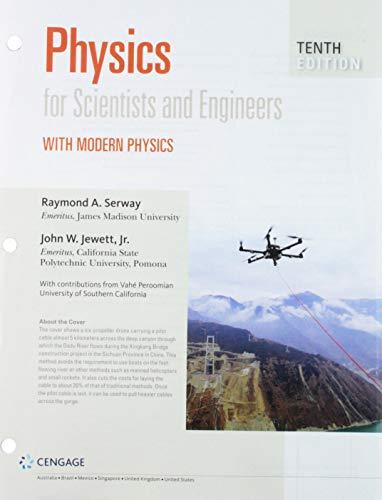
(a)
The fraction by which the transmitted intensity is reduced.
(a)
Answer to Problem 32P
The intensity will be reduced by
Explanation of Solution
Given info: The number of the polarizing filters is
Here,
When an unpolarized light is passed through a polarizing filter intensity is reduced to half. So after passing through the first polarizer the intensity of the light becomes half.
Here,
The angle between the transmission axis of second polarizer and the first polarizer is
Here,
The third polarizing filter and the second polarizing filter has the same
Therefore the final intensity after three polarizing filters is,
Substitute
Substitute
From equation (5), a general formula for the calculation of intensity when light is passed through
Here,
Substitute
Therefore the absorbed intensity is
Conclusion:
Therefore, the fraction by which the intensity is reduced is
(b)
The fraction by which intensity is reduced when
(b)
Answer to Problem 32P
The fraction by which the intensity is reduced is
Explanation of Solution
Given info: The number of filters are
From equation (6) the formula to calculate when there are
Substitute
Therefore the absorbed intensity is
Conclusion:
Therefore, The fraction by which the intensity is reduced is
(c)
The fraction by which intensity is reduced when
(c)
Answer to Problem 32P
The fraction by which the intensity is reduced is
Explanation of Solution
Given info: The number of filters are
From equation (6) the formula to calculate when there are
Substitute
Therefore the absorbed intensity is
Conclusion:
Therefore, the fraction by which the intensity is reduced is
(d)
The comparison between answer of part (a), (b) and (c).
(d)
Answer to Problem 32P
The intensity of light can be increased by increasing the number of stacks of polarizing filters by decreasing the angle between their transmission axis.
Explanation of Solution
From equation (7), (8) and (9), it is evident that, as the number of polarizing filters increased the fraction of absorbed was decreased. For the case of
Conclusion:
Therefore, the intensity of light can be increased by increasing the number of stacks of polarizing filters by decreasing the angle between their transmission axis.
Want to see more full solutions like this?
Chapter 37 Solutions
Bundle: Physics For Scientists And Engineers With Modern Physics, Loose-leaf Version, 10th + Webassign Printed Access Card For Serway/jewett's Physics For Scientists And Engineers, 10th, Single-term
- (a) For a spherical capacitor with inner radius a and outer radius b, we have the following for the capacitance. ab C = k₂(b- a) 0.0695 m 0.145 m (8.99 × 10º N · m²/c²)( [0.145 m- 0.0695 m × 10-11 F = PF IIarrow_forwardA pendulum bob A (0.5 kg) is given an initialspeed of vA = 4 m/s when the chord ishorizontal. It then hits a stationary block B (1kg) which then slides to a maximum distanced before it stops. Determine the value of d.The coefficient of static friction between theblock and the plane is μk = 0.2. The coefficientof restitution between A and B is e = 0.8.Ans: d=1.0034 marrow_forwardFigure 29-43 Problem 12. ••13 In Fig. 29-44, point P₁ is at distance R = 13.1 cm on the perpendicular bisector of a straight wire of length L = 18.0 cm carrying current i = 58.2 mA. (Note that the wire is not long.) What is the magnitude of the magnetic field at P₁ due to i? P2° R R Larrow_forward
- Checkpoint 1 The figure shows the current i in a single-loop circuit with a battery B and a resistance R (and wires of neg- ligible resistance). (a) Should the emf arrow at B be drawn pointing leftward or rightward? At points a, B C R b, and c, rank (b) the magnitude of the current, (c) the electric potential, and (d) the electric potential energy of the charge carriers, greatest first.arrow_forwardPls help ASAParrow_forwardPls help asaparrow_forward
 Principles of Physics: A Calculus-Based TextPhysicsISBN:9781133104261Author:Raymond A. Serway, John W. JewettPublisher:Cengage Learning
Principles of Physics: A Calculus-Based TextPhysicsISBN:9781133104261Author:Raymond A. Serway, John W. JewettPublisher:Cengage Learning Physics for Scientists and Engineers: Foundations...PhysicsISBN:9781133939146Author:Katz, Debora M.Publisher:Cengage Learning
Physics for Scientists and Engineers: Foundations...PhysicsISBN:9781133939146Author:Katz, Debora M.Publisher:Cengage Learning Physics for Scientists and EngineersPhysicsISBN:9781337553278Author:Raymond A. Serway, John W. JewettPublisher:Cengage Learning
Physics for Scientists and EngineersPhysicsISBN:9781337553278Author:Raymond A. Serway, John W. JewettPublisher:Cengage Learning Physics for Scientists and Engineers with Modern ...PhysicsISBN:9781337553292Author:Raymond A. Serway, John W. JewettPublisher:Cengage Learning
Physics for Scientists and Engineers with Modern ...PhysicsISBN:9781337553292Author:Raymond A. Serway, John W. JewettPublisher:Cengage Learning
 Physics for Scientists and Engineers, Technology ...PhysicsISBN:9781305116399Author:Raymond A. Serway, John W. JewettPublisher:Cengage Learning
Physics for Scientists and Engineers, Technology ...PhysicsISBN:9781305116399Author:Raymond A. Serway, John W. JewettPublisher:Cengage Learning





